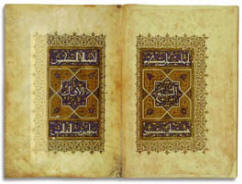|

Introduction
Few books
have exercised a wider or deeper influence upon the
spirit of man than the quran Qurčňn. By Muslims it is
regarded as a revelation from God. It is used in their
public and private devotions, and is recited at
festivals and family occasions. It is the basis of their
religious beliefs, their ritual, and their law; the
guide of their conduct, both public and private. It
moulds their thought, and its phrases enter into
literature and daily speech. A book thus held in
reverence by over four hundred millions of our
fellow-men is worthy of attention. It also demands
serious study; for it is by no means an easy book to
understand. It is neither a treatise on theology, nor a
code of laws, nor a collection of sermons, but rather a
medley of all three, with other things thrown in. Its
'revelation' was spread over a period of some twenty
years, in the course of which muhammad Mu°ammad rose
from the position of an obscure religious reformer in
his native Mecca to that of virtual ruler of Medina and
most of Arabia. As it reflects the changing
circumstances, needs and purposes of the Muslims during
these years, it naturally varies much in style and
content, and even in teaching. Its arrangement is
unsystematic, and though the Arabic in which it is
written is, on the whole, intelligible, there are
difficult passages whose meaning, as the Arabs say, is
known to God alone.
One of the
features of the second half of the twentieth century is
the great increase in contacts between adherents of
different religions. A consequence of this is that it is
no longer possible for the occidental scholar to
pontificate about the religions of Asia as he did in the
nineteenth century. The adherents of these religions now
belong to the same intellectual world as the occidental
scholar, and will criticize him if he fails to
understand and appreciate their religion as a religion.
The term 'dialogue' is often applied to this new
relationship between adherents of different religions.
Though the term is vague, it implies, with reference to
the quran Qurčňn in particular, a reverent attitude
towards it as a holy book and respect for Muslim beliefs
about it, even if these are not shared.
|

![]()
